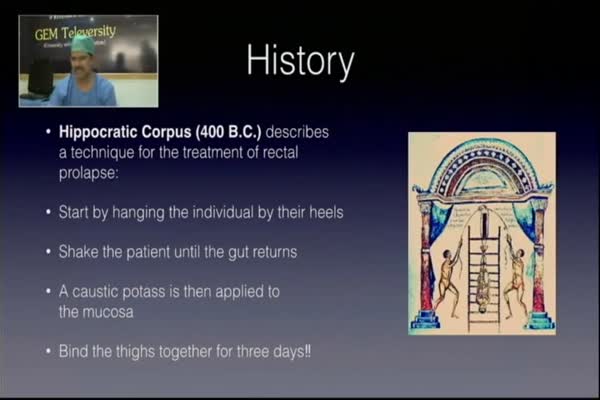Laparoscopic Prolapse Rectum How Do I Do It
Conference Name: MASICON 2016
Surgeon(s)/Speaker(s): Dr. C. Palanivelu
Surgical Procedure: Colorectal-Rectopexy for recurrent prolapse
Location: GEM Hospital & Research Center Coimbatore
Indexsteps
1. Patient position : The patient is placed in a steep Trendelenburg position under regional anesthesia.
2. Marking : First, the rectal prolapse should be confirmed with the apex marked with a suture.
3. Inserting Needle : A needle, with a No. 1 PDS suture (40 mm round body half circle) inserted in to the rectum as high as possible at the right boarder of the window. The needle was then turned under the rectum so that after touching the hard surface brought out across it to an identical point on the other side of window.
4. Grasping of Proctoscope : Once needle comes out of the other (left) boarder of the Proctoscope it was grasped by laparoscopy needle holder.
5. Use of Needle : Then first needle holder released and second needle holder is turned round so that needle comes out.
6. Suturing : The stich was tied with laparoscopy knot pusher. Rectal fixation was performed from approximately from 3rd sacral with typically 4-6 sutures.
7. Insurtion of Gauge Needle : A 20 cm long 20 Gauge needle was inserted through the perineum behind the rectal wall into the retro rectal space. The position of the needle confirmed with transrectal ultrasound if available. Or it can be confirmed with aspiration with 10 ml syringe to check that needle tip is not in a vessel. If needle is in the rectal wall after injection, it will give swelling of the wall. Injection of 4ml of sodium tetradecyl sulphate (30mg/mL) is mixed with 6 mL of air and churned (Tesseri ‘s procedure) into a foam for injection under endo rectal sonographic guidance if available.
port positions
1. Steep Trendelenburg position : Steep Trendelenburg position
pre_post_measures
1. Preoperative investigations : *A detailed clinical history and examination for confirmation of FTRP *Patient’s age, symptoms, medical history, physical examination findings, imaging studies and laboratory test results *Recording of the presence of symptoms of bleeding, prolapse, pain, and burning *Assessment according to the Agachan constipation score and the Pescatori incontinence score
2. Postoperative measures : ▪ The patient should be continued on antibiotics for 5 postoperative days and be provided oral analgesia as required. ▪ The patients must be kept in the bed in a slight Trendelenburg position with a postoperative urinary catheter for 4 days and managed with low dose heparin and anti-embolic stockings. ▪ A liquid diet is advised until the 5th postoperative day post which conversion to a normal diet can be done with the use of lactulose as required. ▪ On discharge, patients should be advised against excessive straining at stool and encouraged to drink plenty of fluids, to eat a diet with a high leafy green vegetable content and where possible to practice Yoga and mindfulness strategies
3. Preoperative measures : ▪ Patient should be given clear liquids and 3 doses of osmotic cathartic lactitol at 4 hourly intervals on the prior day of the procedure. ▪ Metronidazole, ceftriaxone, and sulbactam should be administered intravenously on induction.
Surgical Instruments
1. Dr. Chivate's Proctoscope
2. No. 01 PDS suture
3. 40-mm round body needle
4. Knot Pushers
5. 5mm Needle Holder
6. Babcock forceps
7. 20 cm long 20-gauge needle
8. polidocanol (30 mg/mL
9. Wet gauze soaked in saline solution
